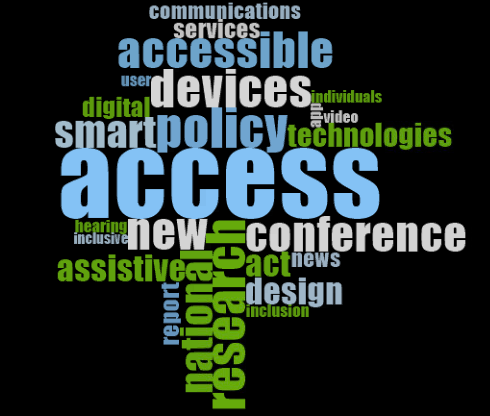- You are here:
- GT Home
- Wireless RERC
- Home
Submitted by Mz22 on February 6, 2020 - 1:50pm

The Wireless RERC produced our annual content review of the TDPH. The top five most cited words for 2019 were access, policy, conference, research, and devices. In contrast, the most prevalent topics in 2018 were emergency, services, research, communications, and inclusive. This past year’s hot topics included the increased access to public space and society via wireless technologies and next-generation connected devices, the continued expansion of accessibility policy, the increased development of assistive technology research and design, and improved inclusive designs of smart devices and other wireless technologies.
The rise of next-generation connected devices was kickstarted in March of 2019 with an FCC ruling. Recall that the FCC voted to broaden the frequency ranges from 95 GHz to 3 THz for possible use with wireless communications as a 6G network. The FCC hoped that it would give innovators strong incentives to develop new technologies using these airwaves while also protecting existing uses. This past summer, the increased access to democratic processes became a reality for residents with disabilities in Colorado. Colorado passed Modifications to the Uniform Election Code (HB19-1278), and Voting Access for People with Disabilities (SB19-202) Acts to expand access to voting for all eligible Coloradans. SB19-202 gave Coloradans with disabilities the ability to vote independently and privately using nonvisual or low vision access technologies.
Furthermore, the development of accessibility policy flourished in 2019. In August, the California Supreme Court provided an expanded opinion in White v. Square, Inc., No. S249248. The issues presented to the Supreme Court delve into whether a plaintiff has experienced discrimination by being denied access or only has limited access to a business’s website, which results in the individual(s) not being able to complete an intended transaction. The California Supreme Court ruled in favor of the plaintiff. The increased development of assistive technology research and design constantly appeared in TDPH stories. In September, the Video Relay Service filing focused on technology access in public spaces.
The improved inclusive design of wireless devices appeared numerous times in our monthly newsletter. At this year’s Worldwide Developers Conference, Apple announced its accessibility efforts, highlighting the HoverText and AssistiveTouch menu as key features that improve accessibility for people with disabilities. HoverText allows the user to place their mouse pointer over a selection of text, and it produces a bubble with said text enlarged. Text can be enlarged up to 128 pt (Herrlinger). Though we have farther to go, 2019 was full of advancements in wireless technology and accessibility.
Finally, Wireless RERC researchers published three regulatory filings. We also kept busy with our three-part YouTube video tutorial series, Unboxing the Echo and Powering it up, What the four top buttons do, and What to expect when synching the Alexa app and your new Echo.
Date of Publication:
Thursday, February 6, 2020


